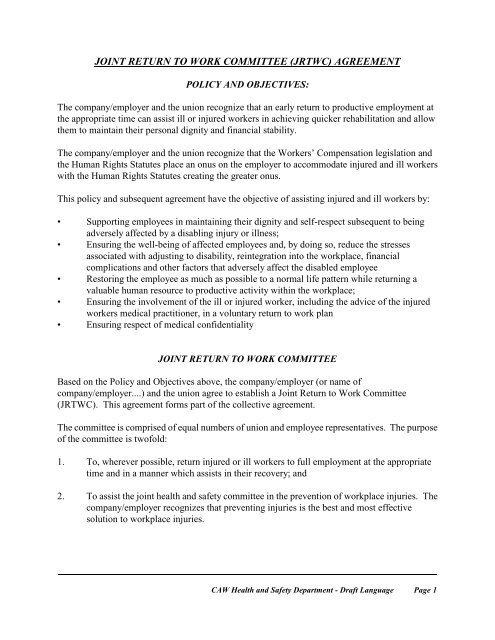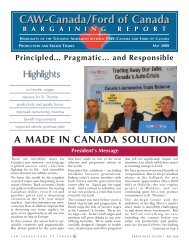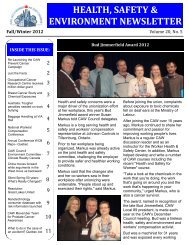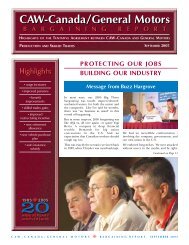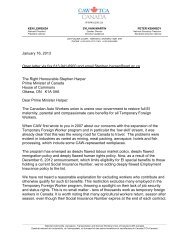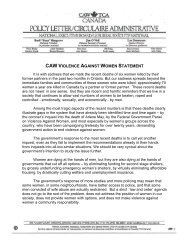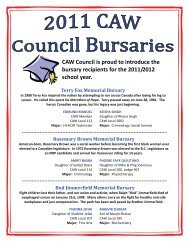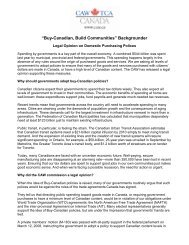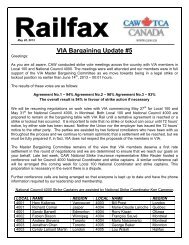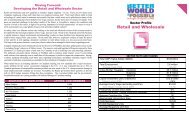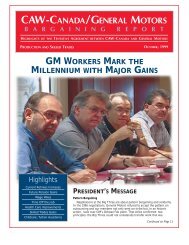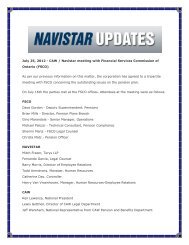joint return to work committee (jrtwc) agreement - CAW
joint return to work committee (jrtwc) agreement - CAW
joint return to work committee (jrtwc) agreement - CAW
Create successful ePaper yourself
Turn your PDF publications into a flip-book with our unique Google optimized e-Paper software.
JOINT RETURN TO WORK COMMITTEE (JRTWC) AGREEMENTPOLICY AND OBJECTIVES:The company/employer and the union recognize that an early <strong>return</strong> <strong>to</strong> productive employment atthe appropriate time can assist ill or injured <strong>work</strong>ers in achieving quicker rehabilitation and allowthem <strong>to</strong> maintain their personal dignity and financial stability.The company/employer and the union recognize that the Workers’ Compensation legislation andthe Human Rights Statutes place an onus on the employer <strong>to</strong> accommodate injured and ill <strong>work</strong>erswith the Human Rights Statutes creating the greater onus.This policy and subsequent <strong>agreement</strong> have the objective of assisting injured and ill <strong>work</strong>ers by:• Supporting employees in maintaining their dignity and self-respect subsequent <strong>to</strong> beingadversely affected by a disabling injury or illness;• Ensuring the well-being of affected employees and, by doing so, reduce the stressesassociated with adjusting <strong>to</strong> disability, reintegration in<strong>to</strong> the <strong>work</strong>place, financialcomplications and other fac<strong>to</strong>rs that adversely affect the disabled employee• Res<strong>to</strong>ring the employee as much as possible <strong>to</strong> a normal life pattern while <strong>return</strong>ing avaluable human resource <strong>to</strong> productive activity within the <strong>work</strong>place;• Ensuring the involvement of the ill or injured <strong>work</strong>er, including the advice of the injured<strong>work</strong>ers medical practitioner, in a voluntary <strong>return</strong> <strong>to</strong> <strong>work</strong> plan• Ensuring respect of medical confidentialityJOINT RETURN TO WORK COMMITTEEBased on the Policy and Objectives above, the company/employer (or name ofcompany/employer....) and the union agree <strong>to</strong> establish a Joint Return <strong>to</strong> Work Committee(JRTWC). This <strong>agreement</strong> forms part of the collective <strong>agreement</strong>.The <strong>committee</strong> is comprised of equal numbers of union and employee representatives. The purposeof the <strong>committee</strong> is twofold:1. To, wherever possible, <strong>return</strong> injured or ill <strong>work</strong>ers <strong>to</strong> full employment at the appropriatetime and in a manner which assists in their recovery; and2. To assist the <strong>joint</strong> health and safety <strong>committee</strong> in the prevention of <strong>work</strong>place injuries. Thecompany/employer recognizes that preventing injuries is the best and most effectivesolution <strong>to</strong> <strong>work</strong>place injuries.<strong>CAW</strong> Health and Safety Department - Draft Language Page 1
To that end the company/employer (or name of company/employer....) agrees <strong>to</strong>:1. make every reasonable effort <strong>to</strong> provide, at the appropriate time 1 , suitable modified oralternate employment <strong>to</strong> employees who are temporarily or permanently unable <strong>to</strong> <strong>return</strong> <strong>to</strong>their regular duties, as a result of an occupational or non-occupational injury or illness. Thiswill include training and/or the modification of <strong>work</strong> stations or equipment <strong>to</strong> accommodatedisabled employees in a manner consistent with the collective <strong>agreement</strong> and according <strong>to</strong>the criteria listed below, providing that such accommodation does not create unduehardship <strong>to</strong> the company (employer).2. assist the <strong>committee</strong> in developing an analysis of injuries and their cause in order <strong>to</strong> provideinformation that can be used in the prevention of future injuries3. make every reasonable effort <strong>to</strong> modify existing jobs when it will assist in preventinginjuries and accommodating disabled <strong>work</strong>ers.4. <strong>work</strong> with the JRTWC, in conjunction with the <strong>joint</strong> health and safety <strong>committee</strong>, <strong>to</strong>modify jobs as is determined necessary <strong>to</strong> prevent future accidents, <strong>to</strong> accommodatedisabled <strong>work</strong>ers and <strong>to</strong> <strong>return</strong> <strong>work</strong>ers effectively <strong>to</strong> the <strong>work</strong> place.5. <strong>work</strong> with the JRTWC <strong>committee</strong> in conjunction with the <strong>joint</strong> health and safety <strong>committee</strong><strong>to</strong> develop job descriptions which will assist in assessing the suitability of the job for aninjured <strong>work</strong>er.The company/employer (or name of company/employer....) and the union agree that the function ofthe <strong>committee</strong> is <strong>to</strong> assist injured or ill <strong>work</strong>ers in an early and safe <strong>return</strong> <strong>to</strong> productiveemployment in the <strong>work</strong> place, implement the <strong>return</strong> <strong>to</strong> <strong>work</strong>, develop and maintain an analysis ofoccupational injuries and illnesses and their cause in order <strong>to</strong> provide information that can be usedin the prevention of future injuries and make recommendations regarding modifying existing jobswhen it will assist in preventing injuries or accommodate disabled <strong>work</strong>ers.MAKEUP OF THE COMMITTEE:The <strong>committee</strong> shall be composed of equal numbers of employer representatives (number..) andunion representatives (number...). Each member of the JRTWC will have an alternate who willattend meetings and conduct business in the absence of the <strong>committee</strong> member.1 Appropriate Time: The company/employer and union recognize that, while early intervention can often beappropriate and useful <strong>to</strong> the recovery of the injured <strong>work</strong>er, both economically and emotionally, it remains for theattending physician <strong>to</strong> determine the appropriate time for the <strong>work</strong>ers’ <strong>return</strong> <strong>to</strong> <strong>work</strong><strong>CAW</strong> Health and Safety Department - Draft Language Page 2
ROLE OF THE COMMITTEEPreventionIn order <strong>to</strong> prevent injuries the company/employer and union agree <strong>to</strong> make every reasonable effort<strong>to</strong> analyze the cause of <strong>work</strong>place injuries and identify preventive measures with respect <strong>to</strong> theredesign of jobs and job assignments.To this end:1. The <strong>joint</strong> <strong>return</strong> <strong>to</strong> <strong>work</strong> <strong>committee</strong> will, in conjunction with the <strong>joint</strong> health and safety<strong>committee</strong>, develop and maintain an analysis of injuries and their cause in order <strong>to</strong> provideinformation that can be used in the prevention of future injuries and make recommendationson modifying existing jobs when it will assist in preventing injuries anc accommodatingdisabled <strong>work</strong>ers.2. The company/employer will provide accident reports and information relevant <strong>to</strong> theanalysis required.3. The JRTWC will develop a physical demands analysis for all jobs.4. The company/employer agrees <strong>to</strong> pay for 16 hours in ergonmics training per year for allmembers of the JRTWC and their alternates. The company/employer also agrees <strong>to</strong> pay losttime for 16 hours of union training. (Alternative: establish a ergo rep who <strong>work</strong>s with theJRTWC - train health and safety <strong>committee</strong> members)Return <strong>to</strong> Work Procedures:(name of company/employer....) will make every reasonable effort <strong>to</strong> accommodate employeescoming within the scope of this <strong>agreement</strong> with suitable alternate, temporary or permanentemployment, by reviewing, and if necessary, modifying their regular duties.In order <strong>to</strong> accommodate a disabled employee the following shall apply in the order listed below:· First, the disabled employee's present position will be considered for modification. Thegoal will be <strong>to</strong> bring the injured/ill <strong>work</strong>er back <strong>to</strong> the essential duties of their preinjury job.· Second, the essential duties of positions within the disabled employee's classification, willbe considered.· Third, the essential duties of positions within the bargaining unit will be consideredThe JRTWC will be responsible for developing a Return <strong>to</strong> Work Plan based on the above criteria.<strong>CAW</strong> Health and Safety Department - Draft Language Page 3
The Return <strong>to</strong> Work Plan should be based on, and tailored <strong>to</strong>, the individual <strong>work</strong>ers’ needs. TheReturn <strong>to</strong> Work Plan should not be an arbitrary mould and should extend <strong>to</strong> the time required <strong>to</strong>benefit of the injured <strong>work</strong>er.The job that the <strong>work</strong>er <strong>return</strong>s <strong>to</strong> should help the <strong>work</strong>er get better. It should be offered at the timeat which the <strong>work</strong>er is ready for, and will benefit, from it. It should be constructive andrehabilitative and it should assist the <strong>work</strong>er in re-integrating in<strong>to</strong> the <strong>work</strong> force. The programshould be consistent with the collective <strong>agreement</strong> and not impose any arbitrary or unnecessaryrestrictions such as permitting no overtime for the employee. The <strong>work</strong>er should suffer no wageloss as a result of accommodation.OCCUPATIONAL INJURIESProceduresA <strong>work</strong>er is expected <strong>to</strong> report an injury at the earliest possible opportunity (failure <strong>to</strong> do so doesnot remove a <strong>work</strong>er from the scope of this <strong>agreement</strong>). Following notification of the injury theemployer/company will fill out the appropriate forms and reports as required by the <strong>work</strong>ers’compensation law and health and safety legislation.The <strong>work</strong>ers attending medical practitioner will receive a letter from the company/employeroutlining the need for information with regard <strong>to</strong> expected date of <strong>return</strong> <strong>to</strong> <strong>work</strong> and restrictionsthat may apply. This letter will include a copy of this JRTW <strong>agreement</strong>.The letter can be sent directly <strong>to</strong> the attending medical practitioner or given <strong>to</strong> the <strong>work</strong>er who willbe expected <strong>to</strong> provide it <strong>to</strong> the doc<strong>to</strong>r. The company/employer will cover all costs; anyinformation obtained will be at no cost <strong>to</strong> the <strong>work</strong>er.The JRTWC may develop a specific set of questions defining the <strong>work</strong>ers functional abilities.Such information will pertain <strong>to</strong> the employees capabilities/restrictions and not thediagnosis. The questions must clearly indicate that the attending medical practitioner will specifywhether and when a <strong>work</strong>er is able <strong>to</strong> <strong>return</strong> <strong>to</strong> <strong>work</strong> and outline the restrictions which apply at thepoint of <strong>return</strong> <strong>to</strong> <strong>work</strong>, including the anticipated rehabilitation period.The union members of the <strong>committee</strong> will receive copies of any accident reports and the attendingphysicians report as <strong>to</strong> restrictions and ability <strong>to</strong> <strong>return</strong> <strong>to</strong> <strong>work</strong>.Should there be any need for representatives of the JRTWC <strong>to</strong> contact the <strong>work</strong>ers’ doc<strong>to</strong>r, theywill do so only with the <strong>work</strong>ers’ written authorization.<strong>CAW</strong> Health and Safety Department - Draft Language Page 4
Once the doc<strong>to</strong>r’s reply has been received the JRTWC will meet <strong>to</strong> review the situation. At thepoint at which the <strong>work</strong>er is ready <strong>to</strong> <strong>return</strong> <strong>to</strong> <strong>work</strong>, the JRTWC will meet <strong>to</strong> develop a Return <strong>to</strong>Work Plan. The Return <strong>to</strong> Work Plan will be developed with the employee in attendance.PERMANENT DISABILITY (OCCUPATIONAL)1. Permanently disabled employees are those who experience an injury/illness thatpermanently restricts their ability <strong>to</strong> perform their regular duties2. In consultation with the employee, the JRTWC will make every reasonable effort <strong>to</strong>establish a permanent modified <strong>work</strong> plan. This assessment will include a revisedmedical prognosis as may be necessary. Such a plan is subject <strong>to</strong> the same criteriaas set out above.3. The Modified Work Plan for a permanently disabled employee may be reevaluatedin the event that relevant circumstances change subsequent <strong>to</strong> the plan'simplementation.4. Accommodation may require an adjustment of <strong>work</strong> process or schedule, financialinvestment made by the company/employer <strong>to</strong> modify a <strong>work</strong> station, <strong>to</strong>ol ormachine, or additional training of reasonable duration5. Accommodating permanently disabled employees may require specialarrangements not provided for by the collective <strong>agreement</strong>. These must benegotiated and <strong>joint</strong>ly agreed <strong>to</strong> by the union and the company/employer.NON-OCCUPATIONAL INJURY OR ILLNESS (WIB)1. A <strong>work</strong>er who is disabled as a result of a non-occupational illness or injury will havethe same rights under this <strong>agreement</strong> as a <strong>work</strong>er disabled as a result of occupationalcauses. Every effort will be made <strong>to</strong> <strong>return</strong> the <strong>work</strong>er <strong>to</strong> <strong>work</strong> in an early and safemanner as provided in this <strong>agreement</strong>.2. Employees wishing <strong>to</strong> participate must have their doc<strong>to</strong>r provide the pertinentinformation, at no cost <strong>to</strong> the employee, as outlined above.S:\Health&Safety 2006 Model Contract Language\Return <strong>to</strong> Work.Model Agreement.2006.doc\cw:jmcope343<strong>CAW</strong> Health and Safety Department - Draft Language Page 5


